Welcome to the Municipality of Nafplion, where every point of interest tells a unique story.
Start your tour from the Beach and the Port, where the lively atmosphere and the beautiful view harmoniously combine nature with the life of the city. Continue with a visit to the Armansperg House, an impressive historic building with an important history. Explore the Land Gate and the Sagredou Gate, two important points that symbolize the historic entrance to the old town.
Don’t miss the Five Brothers Bastion, an imposing monument to Nafplio’s military history, and Psaromachala, a picturesque seaside settlement with a unique aesthetic. Visit the Palamides Library, a cultural beacon of knowledge and learning, and the HARVARD Centre for Greek Studies, a modern centre that inspires and enlightens.
A visit to Nafplio’s points of interest reveals the city’s rich history and cultural heritage, inviting you on a journey of discovery and wonder.
Beach – Harbour
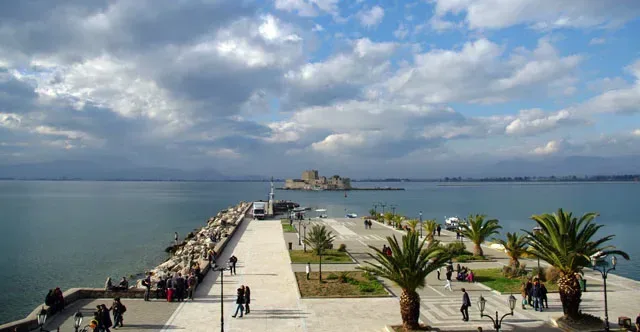
In the time of the first Venetian occupation a sea wall had been constructed where the modern shore is now, leaving only a narrow channel between itself and the Bourtzi.
This channel was closed at night by a chain, and for this reason the port was called Porto Catena; in other words, the port with the chain.
The port of Nauplion was developed inside the area created by the wall, and was one of the most important trading points in the Peloponnese, except during the time of the second Turkish occupation.
A little further down from the ‘Amphitrion Hotel’, about half way down the shore, there was a large 18th century water tank. It was one of the most impressive of the Venetian constructions in the city.
Today, the shore is the ideal place for one to relax in one of the beautiful cafes and enjoy the view towards the Bourtzi, especially at sunset; one may even take a romantic stroll.
The exact location of the shore can be found below.

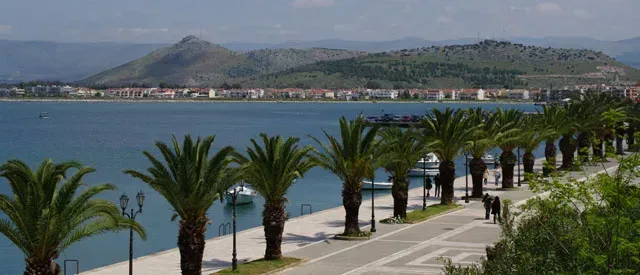
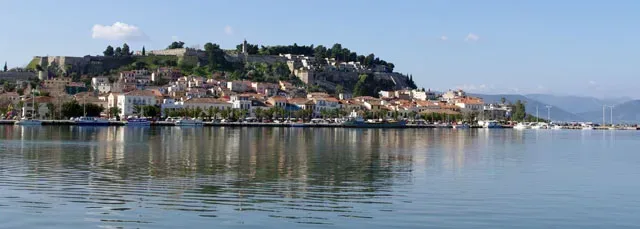
Geographical Coordinates
Beach – Port, Nafplio
- Google Map
- 37.56787220752349, 22.796209110827135
The Armansperg Residence
This is one of the most important mansions from the reign of Otto to be found in Nauplion. The building originally dates from the second Venetian occupation, but it was rebuilt in 1831 and the second floor was added.
The house was home to the president of the regency, Count Joseph Ludwig von Armansperg, during 1833 and 1834. Armansperg was a highly controversial personality, and he has remained best known for the conspiratorial and autocratic nature of his policies.
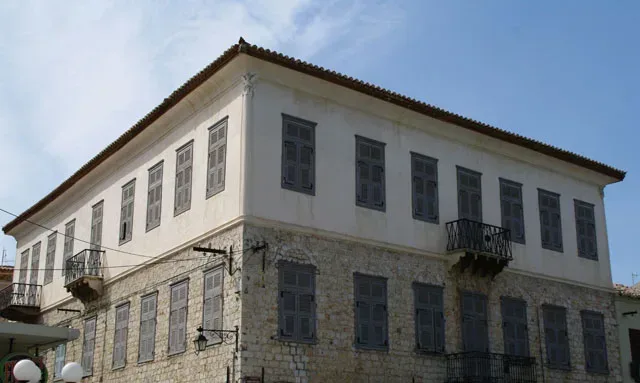
According to witnesses of the time, the house was one of the largest in the city and the interior decoration left nothing to be desired in comparison to the greatest houses in Europe; it hosted receptions and balls with rare, for the time, musical accompaniment on the piano.
At one time, directly opposite the Armansperg residence, there stood the residence of Georg Ludwig von Maurer, the vice-president of the regency.
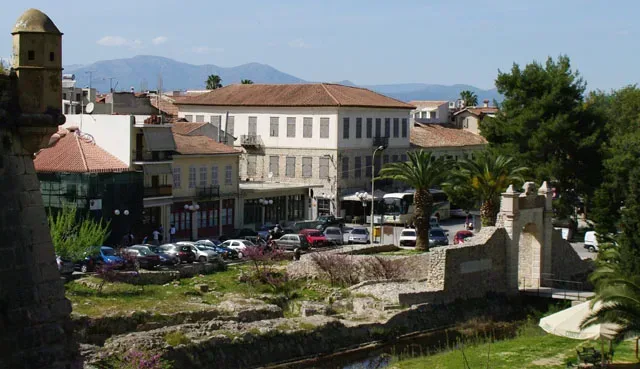
Geographical Coordinates
Plapouta 35, Nafplio 211 00
- Google Map
- 37.5659183421402, 22.802632586155987
The Land Gate
The Land Gate was built in 1708, by the French engineer, and succeeded the earlier gate dating from the first Venetian occupation. It was the only entrance to the city by land and, in fact, the gate would be closed at sunset. Whoever remained outside after that time was obliged to spend the night outside the city, usually in the Pronia suburb. In front of the gate was a moat filled with seawater, which ran along the eastern wall of the city. Access was only possible via a wooden drawbridge.
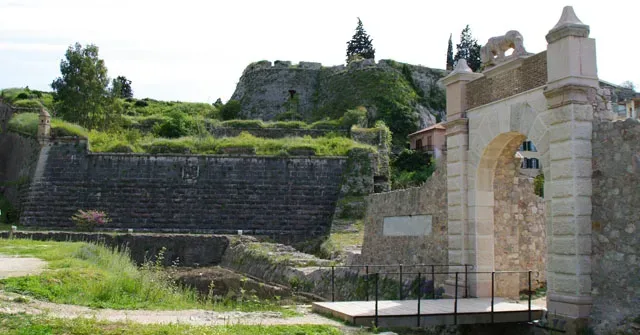
The gate was gradually demolished between 1894 and 1897. In around 1894 the moat was also filled in.
Only a few of the gate’s architectural structures have survived, such as the stone lion from the crown, which is missing the head, the wings and the tail. There is also the family crest of the commander Grimani, with the date 1708.
Today, the façade of the gate has been reconstructed following a special study of its original form.
Basically, the structure of the gate is simple: an arch with two pillars on either side; while at the highest point there was a statue of a lion, the symbol of the Venetian state.
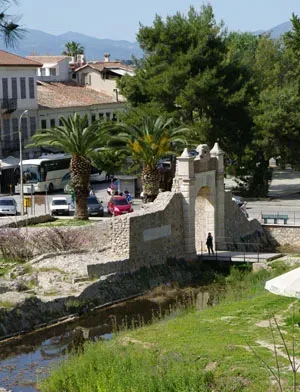
Near to the left-hand pillar there is a plaque, which has been inlaid into the wall, commemorating the liberation of the city by the Venetian general-in-chief, Francesco Morosini in 1687.

Geographical Coordinates
Andreas Syngrou & 25th March, Nafplio 211 00
- Google Map
- 37.56489040694022, 22.80084942442059
The Courthouse
The Courthouse, built with donations from the great Greek benefactor, Andreas Singros, was completed in 1911, from plans by Anastasios Stamatiadis. Today the appeals court is housed in the building, which was constructed in the neo-classical style.

The entrance is decorated with the busts of Anastasios Polyzoidis and Georgios Tertsetis, two great figures, who served the Greek judicial system with exemplary consistency. Both have remained in history for their firm stance during the trial of the leaders of the Greek revolution, Theodoros Kolokotronis and Dimitrios Plapoutas, when in 1834, during the time of the regency, they were accused of conspiracy.
Both the president of the court, Anastasios Polyzoidis, and one of the judges, Georgios Tertsetis, refused to sign the warrant condemning the two to death. Both were removed from the bench for their stance, but were later vindicated and returned to their judicial duties.
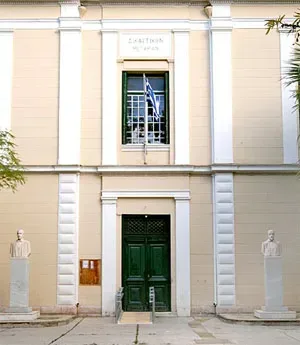
In the southern section of the courthouse square there is a monument to the hero of the Greek revolution who became known as Nikitaras. Nikitas Stamatelopoulos, as he was really called, was a superb soldier. In fact, for a while he was in command of the siege of Nauplion.
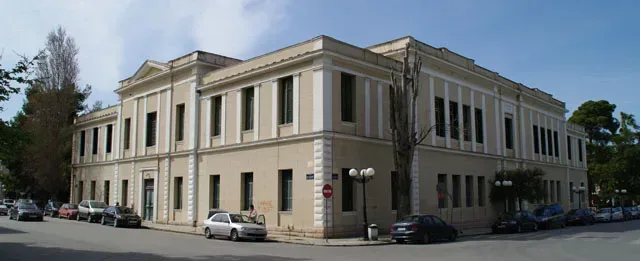
The monument to Nikitaras was erected in 1926 by Aspasia Potamianou, on the wishes of her husband, the Nauplian politician, Elias Potamianos, and it takes the form of a memorial stone. At the base there is a relief design of a battle scene in which Nikitaras kills a Turkish cavalry man with his knife. The sculptor who designed the piece was Antonios Sochos, the nephew of Lazarus Sochos, who created the statue of Kolokotronis. Sochos seems to have been inspired by a mural by Peter Von (H)Ess, which depicts Nikitaras during the battle of Dervenakia. On the reverse side of the monument there is an engraving of verses from a poem by the Greek poet, Kostis Palamas, dedicated to Nikitaras.
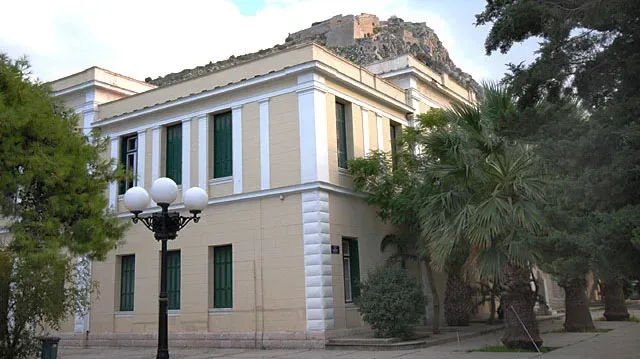
Geographical Coordinates
6 Andreas Syngrou 6, Nafplio 211 00
- Google Map
- 37.56560717278881, 22.800899255570965
The Sagredo Gate
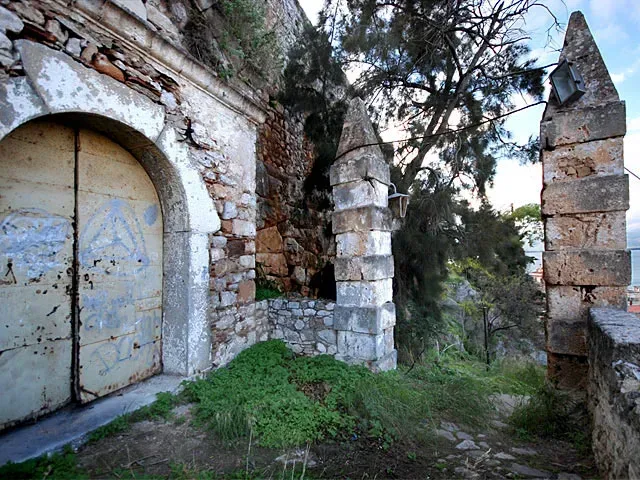

This gate takes its name from the general superintendent of the fleet, Agostino Sagredo, and dates from 1713, the time of the second Venetian occupation of the city.
According to the inscription decorating the gate, Sagredo designed the gate in order for soldiers to have easier access to the lower city from the castle on the Acronauplia, by means of a short road.
It should be remembered that from 1686 civilian habitation had been prohibited in the castle, which since then had been used solely as a fort, and occupied only by military personnel.

Geographical Coordinates
Sagredou Gate, Nafplio
- Google Map
- 37.5651611419184, 22.795649082084676
The Bastion of “Pende Adelphia”
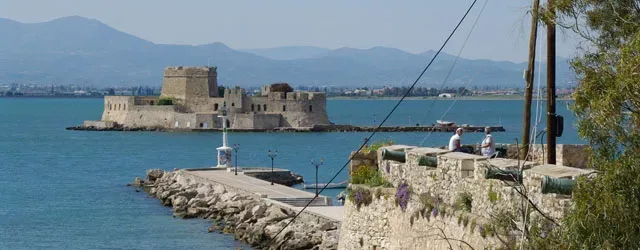
The Bastion of “Pende Adelphia”, or Five Brothers, is the only bastion to escape demolition and survive to the present day. It is on the North West slope of the Acronauplia and owes its name to the five cannons, all the same size, that reinforced its defences.
This bastion protected the western section of the lower city and the harbour, in combination with the Bourtzi. It was probably constructed by the Venetians at around the end of the 15th century. According to some researchers, it must date from later, during the time of the Turkish occupation, as the construction demonstrates some roughness and lack of skill.
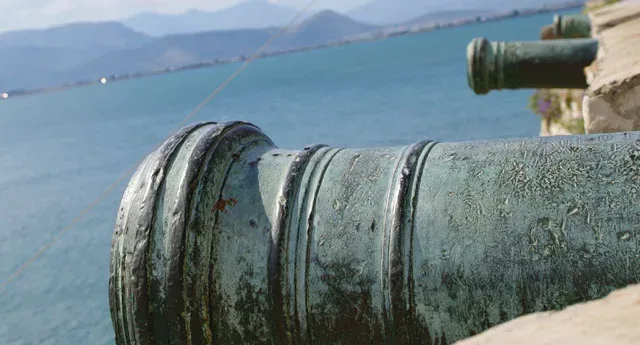

Geographical Coordinates
Nafplio 211 00
- Google Map
- 37.56540854603372, 22.793241377473095
Psaromachalas
Psaromachalas, in other words, the fisherman’s neighbourhood, is one of the oldest and most picturesque neighbourhoods in the city. It covers the north-western foot of the Acronauplia, above Staikopoulos Street.
It was already a settlement during the end of Nauplion’s Byzantine period at the start of the 13th century and was inhabited mainly by Greek merchants and fishermen; which is how it got its name. The Chapel of Aghia Sophia must have been constructed at around this time.
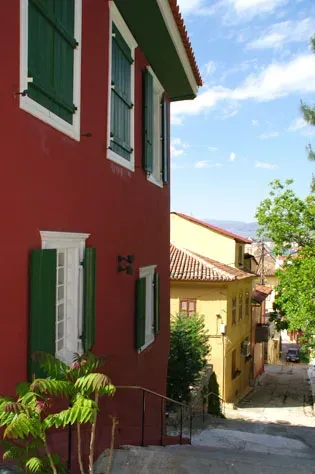
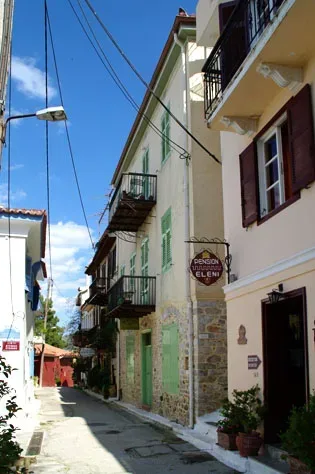
During the difficult times of the second Turkish occupation, Psaromachalas was probably the only neighbourhood inside the city walls to continue to be occupied by Greeks; most of whom were fishermen and moored their boats in the quay below the bastion of Pente Adelphia. It was for this reason that from 1779 to 1780 the only church that the Turks allowed to operate inside the walls was Aghia Sophia.
Today Psaromachalas is one of the most picturesque quarters of Nauplion’s old town. Climbing the characteristic steps, one can see houses from various periods, some renovated: some in ruins. From the highest road one can see a section of The Acronauplia walls.
In what is now Psaromachalas Square there was once a very important hospital for the poor, the first in Greece, a bequest of the Florentine Duke of Athens, Nerio Acciaiuoli.
With the exception of short intervals, the hospital had a long history of operation; from 1394 to the end of the 1940’s, when it was demolished. The only trace left of this important hospital is the Chapel of Aghii Apostoli, which was constructed by the Venetians and was originally located inside the hospital grounds.
The exact location of Psaromachalas can be found below.
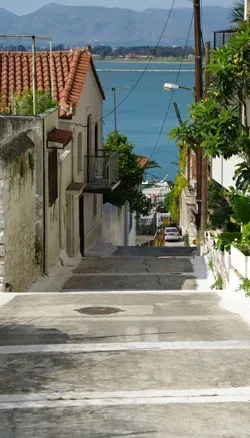
Geographical Coordinates
Psaromachalas, Nafplio
- Google Map
- 37.56536549225329, 22.79412731922659
Palamidis – Library
In 1951, the public library “Palamidis” was founded by the like Institution. It is located in a neoclassical building which was formerly used as a girls’ school.
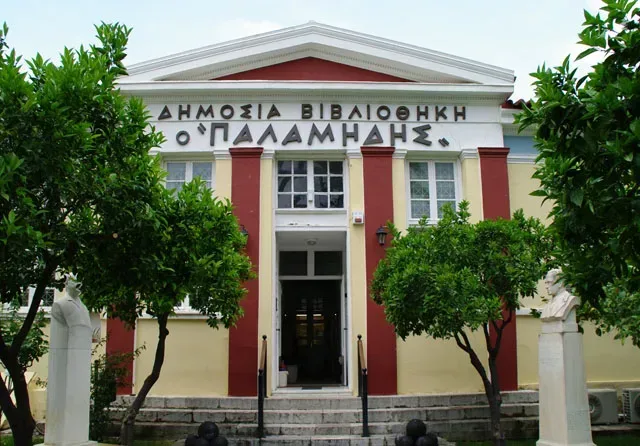
The role of the library was enhanced in the years following the war by becoming a cultural center of the city. It was through donations and charity work that some 3500 books were assembled and were thus offered to the Nafplio citizens in classifying order.
To this present day, the Library holds a 70.000 title record (13.000 literature books and child books). There is also a record being kept of newspaper extracts, some contemporary, others older. What is more, over 700 books dealing with themes from the local community, contemporary magazine reviews, school teaching companions, reference books offer a wide selection of choice.
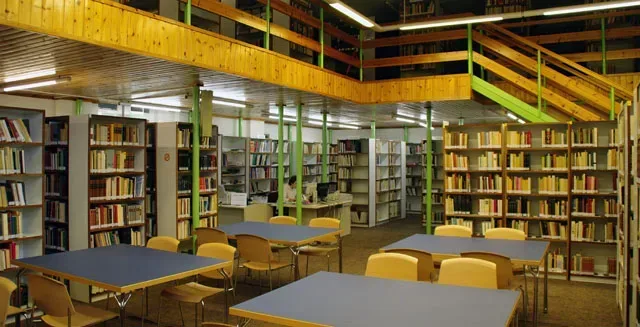
The Library has also placed a lending policy, with thousands of books on the loan scale. There is also a reading room for those wishing to scratch a book from private collections, find data from the audio and visual material extended by the Library itself and surf the Internet charge-free.
Within the chambers of the library, the wonder world of the book is not the only feature one can walk through. The participation of citizens in the cultural activities of the city is also another suggestion. Many distinguished people, of arts and sciences roll up the curtains of the library to project their works and converse with the readers.
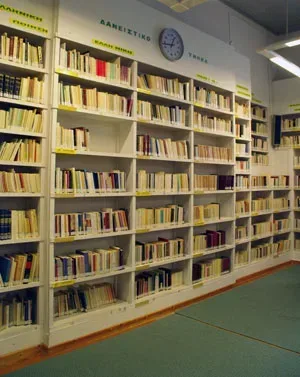
Educational programs usually run for the younger aged readers. For those youngsters who cannot come to the compounds of the library, there is a “Mobile Library Unit”, lending books to children and teenagers.


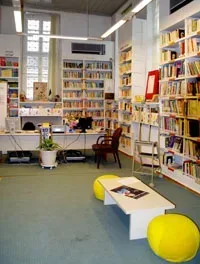
The Palamidis Library, finally, gives the opportunity to everyone to search in our website (https://palamidis.arg.sch.gr/) (https://palamidis.arg.sch.gr/) for any reference material or book title.
https://vivl-nafpl.arg.sch.gr/ is the website address for anyone wishing to find more information on the PALAMIDIS Library.
Geographical Coordinates
Kolettis 3, Nafplio 21100
- Google Map
- 37.56668219682616, 22.797273577612838
Center for Hellenic Studies, HARVARD
The Center for Hellenic Studies in Greece (CHS Greece) is a Harvard global office. It operates as an interdisciplinary hub of the University abroad that links the Harvard community to local academic institutions, authorities and other organizations and communities, uniting the humanistic pursuits of its twin institution, CHS in Washington, DC (CHS US), with the homeland of Hellenism.
From its inception, CHS Greece was conceived and established to be accessible and free of charge to the general public. It maintains two equally significant operational priorities. One is to organize, collaborate on, and support activities addressed to the Harvard community. The other is to engage with educational and non-educational communities in Greece and around the world through a multitude of programs and other initiatives.
CHS Greece offers its activities to the community free of charge. The Center’s main mission is to support and promote the study of Hellenic civilization through the use of interdisciplinary and intergenerational approaches. At the same time, it serves as a base of operations for scholars, students, and researchers from Harvard and other academic institutions from the US, Greece, and elsewhere.

In 2003, The Municipality of Nafplio decided to proceed with the renovation of the neoclassical Megaron Iatrou (formerly hosting Nafplio’s Town hall) and to lease this historical building to CHS in order to house the Center’s Greek branch. CHS Greece opened to the public on June 28th, 2008.
Α. DIGITAL LIBRARY
The “Georgios Vernardakis” Digital Library on the Center’s second floor is open to visiting researchers—free of charge—and its constantly enriched collection offers a database with millions of digital items (books, journals, manuscripts, files, maps, microfilms, and musical scores as well as audio and visual material) from all academic fields and disciplines.
The Digital Library welcomes researchers daily (Monday-Friday 10am-5pm via phone reservation) and is perhaps the best expression of the Center’s mission summarized in the phrase “free access to knowledge for everyone.”

Β. ACTIVITIES
CHS Greece organizes, co-organizes and supports a series of programs, which are addressed to the Harvard community but also to the Greek and global educational- and non-educational community, creating links between them.
1. Seminar-based Programs. They are held every year in Nafplio and/or other parts of Greece for several weeks and are addressed to Harvard students and professors, students of Greek, Chinese and other Universities, Greek high school students (mainly from Argolis), etc.
2. Research Opportunities. CHS Greece supports in a number of ways (administratively, organizationally, etc.) research opportunities, which are offered by CHS US. These opportunities focus on the hellenic culture and its mark across space and time, with an emphasis on collaborative and interdisciplinary approaches. Research opportunities are addressed to pre- and post-doc researchers from Greece, Cyprus, and other countries.
3. Internships. Based on synergies with other Harvard units and important Greek museums and organizations, CHS Greece offers annually a number of opportunities to Harvard undergraduate and graduate students to spend several weeks living and working in Greece and gaining experience while collaborating with unique museum collections and projects, Greek high school students, as well as Harvard faculty. In addition, CHS Greece collaborates with the Department of Theatre Studies of the University of the Peloponnese supporting internships offered to students of the Department in Nafplio throughout the academic year.
4. Workshop Series. Every year, the Center offers a series of workshops, which are addressed to people of all ages and all educational backgrounds. The workshops are organized by experts in various fields who take on the role of coordinator and are conducted at the Center’s “Iatrou” building in Nafplio
5. Travel Study Programs. CHS Greece supports and hosts a series of travel study programs, organized in collaboration with the Harvard Alumni Association (HAA) and/or other American educational institutions. These programs, which are addressed to life-long learners and students, consist of educational trips that combine traveling and study in Greece
C. EVENTS AND OTHER INITIATIVES
CHS Greece offers a large number of events & other Initiatives, including symposia, conferences, events, etc. These initiatives are addressed to Greek and international audiences and many of them are based on important synergies developed by the Center or based on proposals for collaborations by other institutions
1. Events Series. Events Series is one of the longest-running CHS Greece activities, launched in 2008. The Center invites prominent academics and experts from various fields from Greece and abroad, and addresses the local communities of Argolis and Greece in general, through an annual series of lectures, panel discussions, and presentations that take place on a monthly basis. Each annual cycle of the Events Series engages with a new general topic
2. Digital Library Program (DLP). The program is designed to introduce participants to the digital methods used for the dissemination of knowledge by academic institutions such as Harvard and the CHS. The program is addressed mostly to secondary education students. It can be easily adjusted to the educational level and needs of the attending students, including undergraduates.
3. Conferences & Symposia. CHS Greece organizes and/or supports a number of annual and one-time symposia and conferences Symposium on Sports, Society, & Culture, co-organized by the International Olympic Academy (IOA). Depending on the organization and the thematic area, the activities are open to undergraduate and postgraduate students of Greek Universities and the general public.
4. CHS Greece at Harvard. CHS Greece is a dynamic international center (global office of Harvard University) and has an active presence on the Cambridge, MA campus too.
The Center participates actively in various collaborative efforts and events which take place every year in Cambridge, coordinated by the Office of the Vice Provost for International Affairs (OVPIA) and other offices of the University promoting Greece and Nafplio and aiming to establish new collaborations and activities in the area.
5. More initiatives. CHS Greece from its early days has been working together with institutions, authorities, and universities in Greece and around the world. CHS’s goal is to enhance different aspects of education and knowledge, forging new partnerships that fit the Center’s profile and operation, and creating the conditions for more initiatives to be organized in Greece. The Center collaborates in various activities with the Municipality of Nafplio, the University of the Peloponnese, the Argolis Association of Philologists, the University of Patras, etc., while each year it hosts a number of other American educational institutions, which now carry out their programs or part of them in Nafplio.
Geographical Coordinates
Philellinon Square and Othonos Street, 21100 Nafplio
- Google Map
- 37.5674426632278, 22.79669897923805
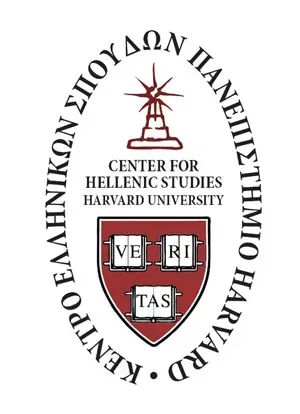
The Arvanitia Promenade
The Arvanitia Promenade, as it is characteristically known by local residents, is one of the most popular walks in Nauplion. It starts at the end of the shore and leads to Arvanitia Square, a total distance of about 1 kilometre.
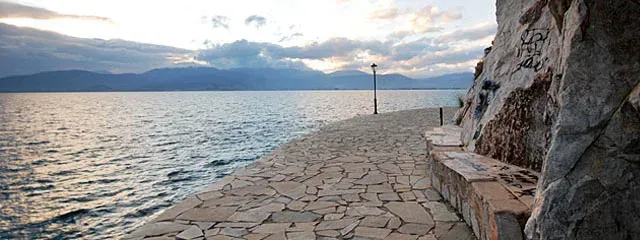
The whole of the route is dominated by the rock of the Acronauplia with its impressive walls. About half way through the walk one comes across a small church perched on the rocks; a favourite place to visit for residents and visitors alike.
It is known locally as Panagitsa, Panaghia tis Spilias, or Santa Maria della Grotta to the Venetians. The view of the Gulf of Argolis from this spot is unique.

The walk comes to an end in Arvanitia Square. According to local tradition, this area was given the name of Arvanitia because it was from off these rocks that Kapetan-Pasha threw the Albanian mercenaries who had overrun the area in 1779.
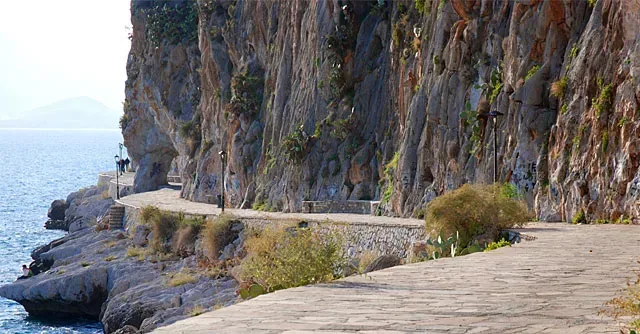
In reality, the name is due to the fact that Albanians had inhabited the area outside the walls and to the east of the Land Gate since before the time of the first Venetian occupation.
Further down from the square there is an organised beach area, where one can go to relax, sunbathe and swim.
Moving on from the square, one can continue walking to the east, along the foot of the Palamidi and reach the sands of Karathona; a total distance of about 2.7 kilometres.
If one wants to return to the old town from the square, one should head downhill towards Staikopoulos Park and the Land Gate.
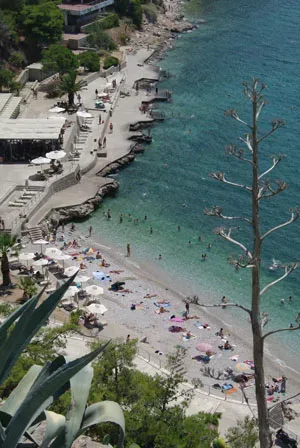
Geographical Coordinates
Arvanitia, Nafplio
- Google Map
- 37.56351024881726, 22.79630317746808
Vouleutikon
The Parliament building, which is located in the south-west sector of Syntagma Square, holds a special place in Greek history, as it was here that the parliament of the rebellious Greeks met.
It dates from 1730, the time of the second Turkish occupation of the city, and was originally built as a mosque. It was built in ashlar masonary and consists of a square chamber with a large dome. It is a characteristic mosque of the late Ottoman architectural period, with its heavy proportions and bulky dome. To the west there was once a domed portico, but this fell down during an earthquake at the beginning of the 20th century.
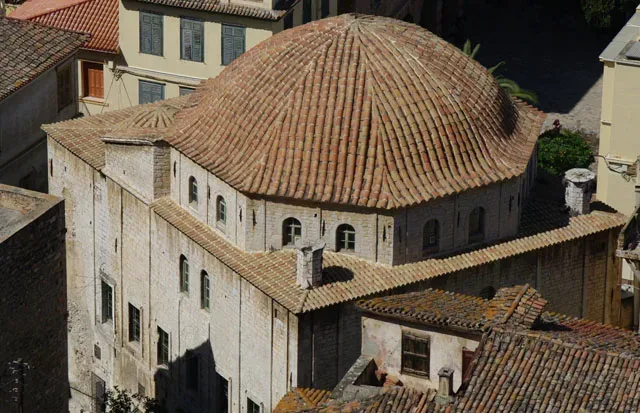
According to local tradition, this mosque was built by a rich Turkish Aga in order to redeem his soul from a heinous crime that he had committed: the Aga had killed two young Venetians who had come to Nauplion to find the treasure that their father had hidden when the city was occupied by the Venetians. The Aga found the treasure following the map that was in the possession of the two men, but he killed them in order to keep the loot for himself. Later, filled with remorse for his hideous crime, it is said that he used the gold he had stolen to build the large mosque in the square, which became known as the mosque of Aga-Pasha.
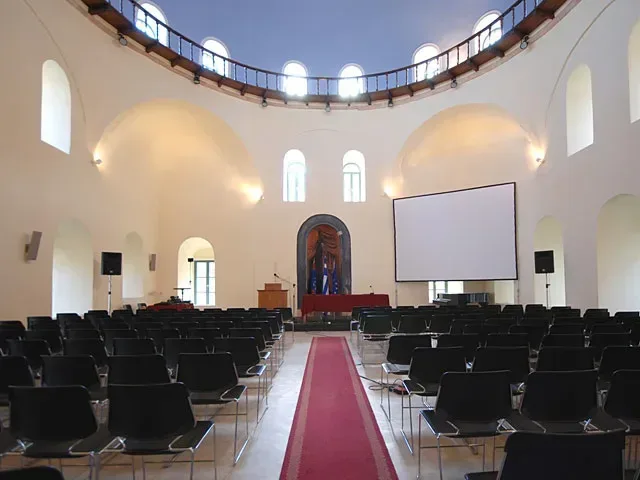
After the liberation of the city from the Turkish yoke the mosque was used to house the Greek Parliament, from the autumn of 1825 to the spring of 1826, after suitable remodelling by the architect Vallianos. This was its most important use, and the name of ‘Vouleftiko’ or ‘Parliament’ has remained in use to the present day.
As with many of the most important buildings in the city, with the passing of time it has been used for a variety of purposes.
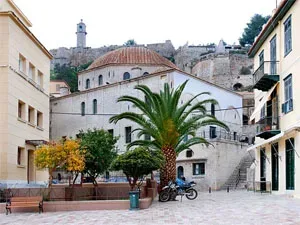
In 1831 it housed the Greek School for a short time, while the ground floor was used as a prison. During the time of Kapodistrias and Otto, from 1828 to 1834, it was here that public dances were held. In 1834, during the regency period, the trial of the chiefs of the Greek revolution, Theodoros Kolokotronis and Dimitrios Plapoutas, was held here.
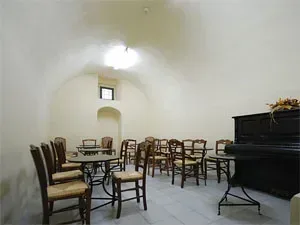
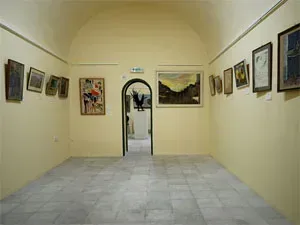
Today, the Parliament has been exemplary restored by the Ministry of Culture and serves as a meeting place, where, in addition to conferences, most other cultural events take place.
The Municipal Art Gallery of Nafplio with an interesting collection of paintings by contemporary Greek and Greek artists was recently moved to the ground floor of Bouleutiko. The works are donations mainly from the Potarian Group of Nafplion and the Nafplion Nikolaos Karagiannis.
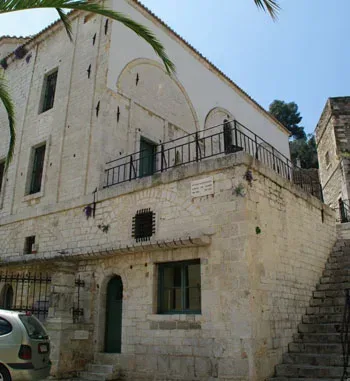

Geographical Coordinates
The Parliament Building, Nafplio
- Google Map
- 37.56589190083003, 22.796255346411865
Syntagma Square
Syntagma Square, the most important and historic square in Nauplion, comprises the centre of the city. It is assumed that from 1540, the time of the first Turkish occupation, the Turkish commander of the Peloponnese, Mora-Pasha, had his seraglio here.
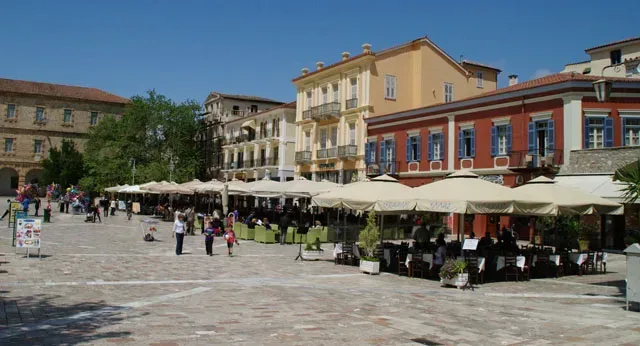
The importance of the square is also demonstrated by the number of times it has undergone a change of name. In the 19th century it was known as ‘Platanos Square’ or simply ‘Platanos’, for the plane tree which once occupied the centre, in the shade of which national politicians made speeches. In 1843 the name was changed to ‘Ludwig Square’, in honour of Ludwig, father of King Otto, who had then visited the city. In the same year, after the revolution of 3rd September 1843, when the Greeks demanded that Otto grant them a constitution, the name was changed first to Syntagma (or constitution) Square, then ‘Stratonas Square’, and ‘King George II Square’.
Today, one can see many important historic buildings in the square, such as the Venetian Warehouse of the Fleet, which today houses the Archaeological Museum; the parliament, former mosque of Aga-Pasha and finally the Allilodidaktiko School, which came to be known as the ‘Trianon’.
The square was also once home to the residences of many of the great fighters of the Greek revolution, such as Nikitaras and Theodoros Kolokotronis
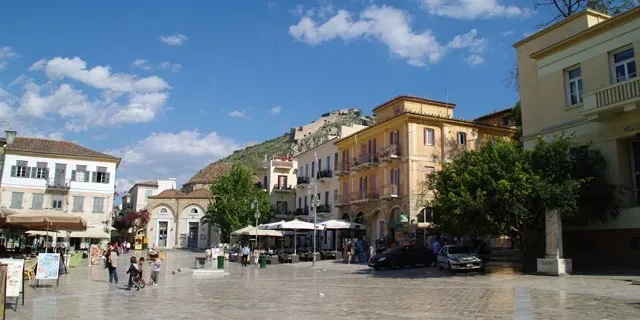
The episode known to modern Greek history as ‘Psorokostaina’ took place here. In 1826, when the rebellious Greek nation was in dire financial need, the man who became known as the teacher of the nation, Georgios Gennadios, delivered a moving speech from under the plane tree, encouraging the people of Nauplion to contribute to the appeal for the nation. His speech was so moving that the poorest woman in the city, known mockingly as ‘Psorokostaina’, gave all her possessions, which were nothing more than a silver ring and a gross.
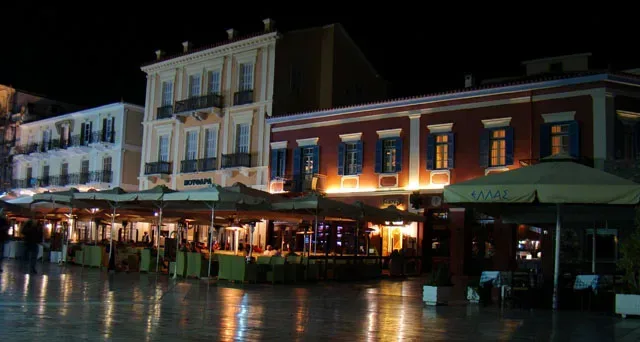
On the spot where the National Bank now stands, there was once the home of Kalliopi Papalexopoulou, which was built after the liberation of the city from the Turkish yoke. Mrs Papalexopoulou, the wife of the mayor of Nauplion, Spyridon Papalexopoulos, was at the head of the revolutionary movement for the removal of King Otto from Greece. In fact, it is said that her home was the centre for the organisation of the Nauplian revolution, which lasted from February to March 1862. Today, there is a monument to her memory outside the National Bank.
The building of the National Bank dates from around 1930 and is the work of architect Zouboulidis. It has been influenced by the palaces of Mycenae, and is only a step away from the neo-classicism of the 1930s.
The exact location of Syntagma Square can be found below.
Geographical Coordinates
Syntagma Square, Nafplio
- Google Map
- 37.56621188291986, 22.796738245279784